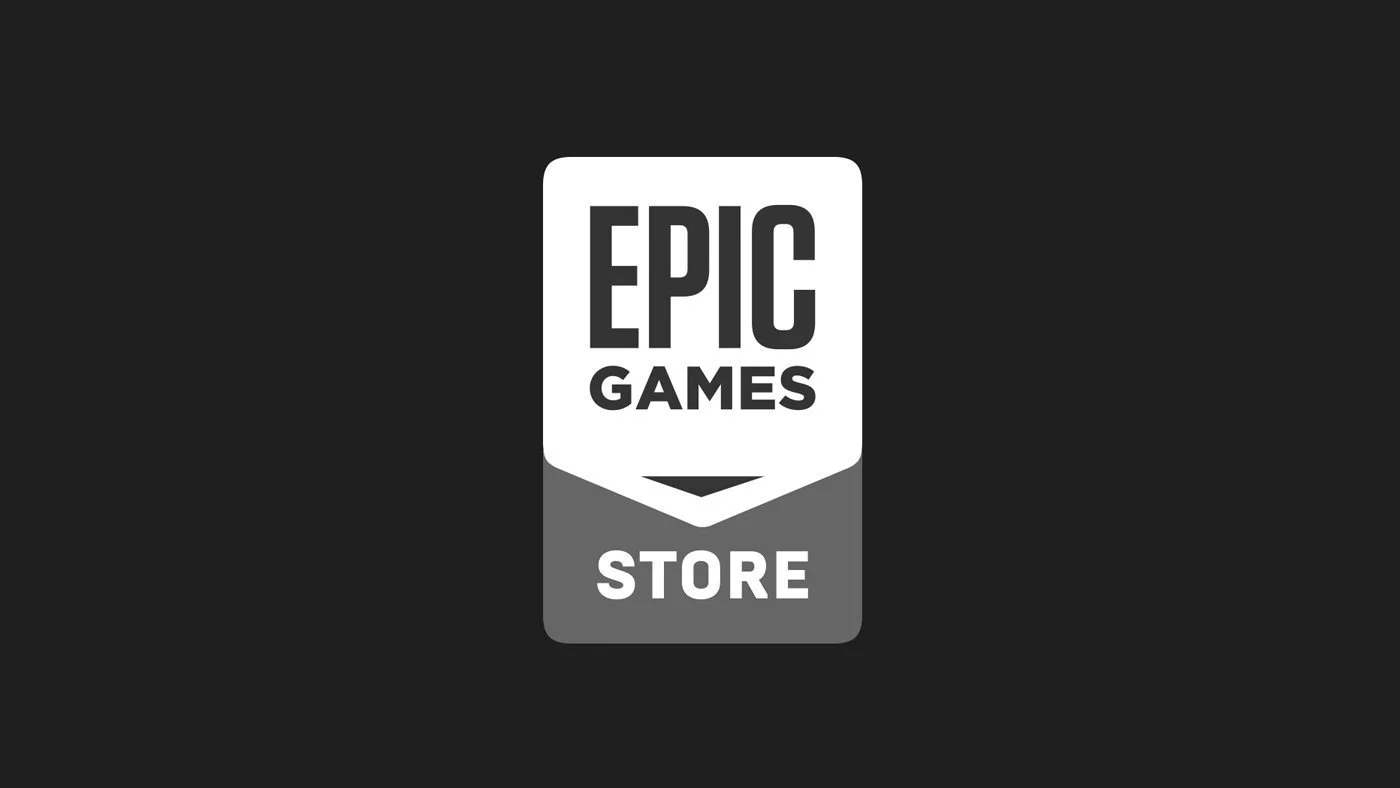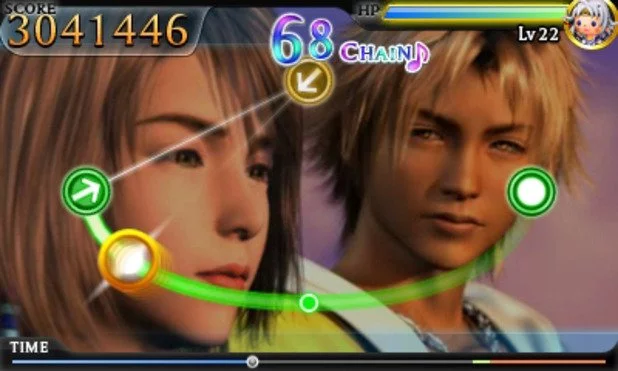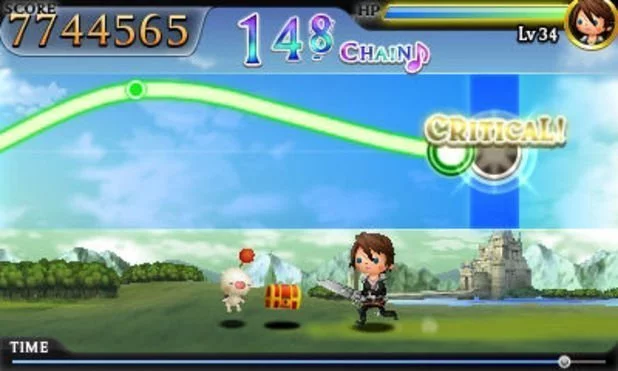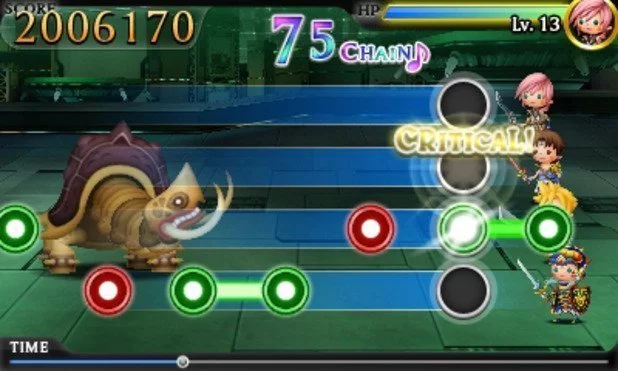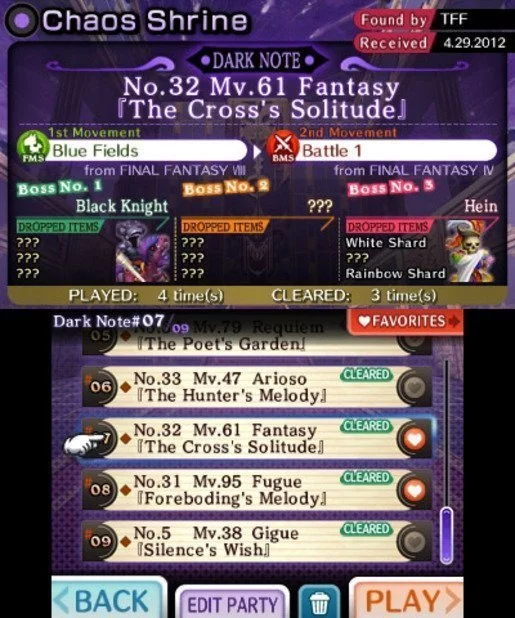Theatrhythm Final Fantasy can best be described as a rhythm action game with RPG elements. On the surface, it may appear a standard rhythm game, however its simple façade hides an amazing level of complexity that will have you addicted in no time…providing you like the music of Final Fantasy, of course.
The game is played by tapping, holding or sliding your stylus in time with the music as directed by triggers on the top screen. If you miss a trigger or score a bad hit you lose health points (HP). Run out of HP and it’s game over.
The game hosts three different music stage types, each with it’s own unique style, bonuses and strategy. Field Music Stages (FMS) play relaxed music and have you dealing with triggers on a single lane; Battle Music Stages (BMS) are fast paced and have the triggers coming down four lanes; and Event Music Stages (EMS) are very slow with your mark moving around the screen. In those you’re required to hit the triggers as your mark passes over them.
To further emphasise the FF RPG side of this game each stage has a section called a feature zone. During these sections all triggers turn silver and, if you manage to hit every one, you activate a special. In FMS you turn into a Chocobo and run super-fast, in BMS you perform a summon and EMS lets you play an extended version of the song thus increasing your chance for items.
You have a set amount of time to complete each stage however your performance isn’t determined solely by your ability to reach the end of the song. Theatrhythm sets itself apart from other rhythm games by incorporating RPG elements you wouldn’t normally expect to find outside a full Final Fantasy RPG.
Before setting out you’re asked to create a party of four. Initially you choose one character from each of the 13 Final Fantasy games however, as you progress, more become available. Each character has unique HP, stats and abilities which directly affect the results of the music stages you play.
FMS stages see your character running through the field. The better you perform, the faster your character runs; the faster your character runs, the more distance you cover meaning you find more items. In these stages luck and agility are important as they directly affect your speed and the rarity of items found. For BMS stages you’re fighting monsters so you want character with high magic or strength. If you’re able to defeat monsters quickly you have more chance of getting to a boss fight and earning some rare drops. I couldn’t figure out what the important stats for EMS were but I assume they are luck, as it improves the items you find, and agility because it minimises the damage you receive.
If the combination of base stats and performance aren’t enough for you, characters can be further augmented with items and abilities. Each party member can hold 1 item (found in FMS and EMS) and equip 4 abilities (earnt by levelling). When equipped they activate automatically based on specific requirements. For example; a high potion will activate when your HP falls below 15%. It will refill 50% of your gauge but can only be used once. The counter ability is also reactive and deals 5x physical damage when three triggers are missed in BMS.
This is where the strategy of the game really comes into play. Take a BMS for example; you critical every single note in the score yet still manage not to beat a boss. Now equip your guys with some proactive abilities like “strength up”, “magic up”, a potion and a skill like counter. This time, when fighting the bosses purposefully miss three notes in a row and watch how much damage the counter skill does. You’re suddenly doing more damage than before and progressing further in the level. Sure you’re losing health and not getting a perfect hit rate but you’re able to beat that boss and get further in the level which is what BMS is all about.
All characters start out fairly weak however characters can be levelled up by completing stages and earning EXP. As you would imagine higher level characters have better HP, stronger base stats and more abilities to equip. It’s a great incentive to redo levels and considerably more enjoyable than the usual drivers of beating your own score or trying for “perfect”.
One thing I found lacking in Theatrhythm was that it didn’t provide a proper single player story. When you start the game you’re presented with a paragraph introducing Rhythmia then, after you collect 10,000 Rhythmia crystals, you get another paragraph complementing you on finishing the game. I felt it was a missed opportunity as the game’s structure would lend itself to an original “campaign” perfectly.
That said playing through the music and reliving the cut scenes was sensational and, I must admit, a little emotional. Final Fantasy always had an exceptional score and the ability to make me happy, sad, nostalgic, etc. In this case, many of the songs had the interesting side effect of making me want to dig out all my Final Fantasy games and replay them! Well played, Square Enix. Well played.
Although it lacks a traditional “story mode” Theatrhythm does have 3 different play modes to keep you busy; Series, Challenge and Chaos Shrine. Series mode allows you to play pre-set courses containing 5 song sets from each of the 13 Final Fantasy games; Challenge mode lets you choose individual songs from each set and play them on basic, expert or ultimate difficulty; and Chaos Shrine has you taking part in special challenges either by yourself or with up to three others. Sadly the coop mode is restricted to local wifi and feels like another opportunity missed.
Outside the core game there’s quite a bit to keep you going. There are trophies to unlock, dark notes to collect (they unlock levels in Chaos Shrine Mode), collector cards to find, crystal shards to gather and secret characters to unlock. If you’re super keen there’s also a bunch of DLC songs you can buy to introduce some variety into the game. Theatrhythm supports Streetpass but it’s limited to exchanging statistical information and dark notes. A nice addition to Theatrhythm is its museum section where you can view statistics and collectibles, re-watch cinematic sequences or listen to music. It’s a great feature to have as you don’t get the opportunity to properly appreciate the visuals whilst concentrating on the game.
Graphically, Theatrythm is beautiful. The interface is easy on the eye and even the oldest of cutscenes looks sharp and well defined. Sadly the 3D was just used to “layer” the lanes in front of the background images so I ended up turning it off. Actually this is one of those rare games where it’s significantly easier to play without the 3D on at all.
In summary Theatrhythm is amazing. At first it feels like a minigame more suited as an extra in the Gold Saucer but you soon learn the simple stylings hide a complex and involved title. To use the old adage it’s simple to learn yet hard to master. If you’re not a fan of Final Fantasy it might pay to hold off for the inevitable Theatrhythm Kingdom Hearts, Star Ocean or Dragon Quest. That said it’s a game that should be enjoyed by both rhythm and Final Fantasy fans alike so, if you think that sounds like you, grab the free demo from the Nintendo eShop and give it a shot.
This article may contain affiliate links, meaning we could earn a small commission if you click-through and make a purchase. Stevivor is an independent outlet and our journalism is in no way influenced by any advertiser or commercial initiative.



